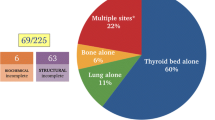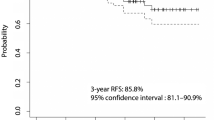Abstract
Context
The American Thyroid Association (ATA) risk stratification system predicts risk of recurrence of differentiated thyroid cancer (DTC). Although the majority of patients achieve an excellent response, patients with intermediate- or high-risk DTC are at a significant risk of developing incomplete responses. We undertook this work to understand the factors associated with development of biochemically or structurally incomplete response in these two risk subgroups of DTC.
Patients and methods
We retrospectively reviewed 287 consecutive patients with intermediate- (213 patients) or high-risk (74 patients) DTC. All patients underwent total thyroidectomy with (223 patients) or without (64 patients) lymph node dissection and 94% of them received at least one dose of I-131ablation/therapy. Univariate and multivariate analysis and Kaplan Meier analysis were used to compare patients who achieved an excellent response with those who continued to have biochemically or structurally incomplete responses.
Results
In univariate and multivariate analyses, age (P 0.002, Odds ratio 4.8, 95% CI: 1.8–12.9), tumor size (P 0.027, Odds ratio 1.30, 95% CI: 1.03–1.64) and distant metastases (P < 0.0001, Odds ratio 44.6, 95% CI: 10.7–184.5) were significantly associated with the risk of developing biochemically or structurally incomplete statuses. Patients ≥ 55 years, tumors > 2.5 cm and presence of distant metastasis were associated with higher risk of incomplete response and death from DTC. However, when this analysis was performed on intermediate and high-risk groups separately, only age was consistently associated with risk of biochemically or structurally incomplete response in either and both groups.
Conclusion
Age is a strong predictor of biochemically and structurally incomplete responses in patients with intermediate and high-risk DTC.


Similar content being viewed by others
References
B.R. Haugen, E.K. Alexander, K.C. Bible, G.M. Doherty, S.J. Mandel, Y.E. Nikiforov et al. 2015 American thyroid association management guidelines for adult patients with thyroid nodules and differentiated thyroid cancer: the American thyroid association guidelines task force on thyroid nodules and differentiated thyroid cancer. Thyroid. Off. J. Am. Thyroid. Assoc. 26(1), 1–133 (2016). https://doi.org/10.1089/thy.2015.0020
R.M. Tuttle, A.S. Alzahrani. Risk stratification in differentiated thyroid cancer: from detection to final follow-up. J. Clin. Endocrinol. Metab. 2019. https://doi.org/10.1210/jc.2019-00177
F. Vaisman, R.M. Tuttle, Clinical assessment and risk stratification in differentiated thyroid cancer. Endocrinol. Metab. Clin. North Am. 48(1), 99–108 (2019). https://doi.org/10.1016/j.ecl.2018.11.002
A.S. Alzahrani, L. Albalawi, S. Mazi, N. Mukhtar, H. Aljamei, Y. Moria et al. How does the AJCC/TNM staging system eighth edition perform in thyroid cancer at a major middle eastern medical center. Endocr. Pr. 27(6), 607–613 (2021). https://doi.org/10.1016/j.eprac.2020.11.018
A. Campennì, D. Barbaro, M. Guzzo, F. Capoccetti, L. Giovanella, Personalized management of differentiated thyroid cancer in real life—practical guidance from a multidisciplinary panel of experts. Endocrine 70(2), 280–291 (2020). https://doi.org/10.1007/s12020-020-02418-x
D.P. Byar, S.B. Green, P. Dor, E.D. Williams, J. Colon, H.A. van Gilse et al. A prognostic index for thyroid carcinoma. A study of the E.O.R.T.C. Thyroid Cancer Cooperative Group. Eur. J. Cancer 15(8), 1033–1041 (1979). https://doi.org/10.1016/0014-2964(79)90291-3
R.M. Tuttle, H. Tala, J. Shah, R. Leboeuf, R. Ghossein, M. Gonen et al. Estimating risk of recurrence in differentiated thyroid cancer after total thyroidectomy and radioactive iodine remnant ablation: using response to therapy variables to modify the initial risk estimates predicted by the new American Thyroid Association staging system. Thyroid.: Off. J. Am. Thyroid. Assoc. 20(12), 1341–1349 (2010). https://doi.org/10.1089/thy.2010.0178
F. Pitoia, F. Bueno, C. Urciuoli, E. Abelleira, G. Cross, R.M. Tuttle, Outcomes of patients with differentiated thyroid cancer risk-stratified according to the American thyroid association and Latin American thyroid society risk of recurrence classification systems. Thyroid.: Off. J. Am. Thyroid. Assoc. 23(11), 1401–1407 (2013). https://doi.org/10.1089/thy.2013.0011
A.S. Alzahrani, Y. Moria, N. Mukhtar, H. Aljamei, S. Mazi, L. Albalawi et al. Course and predictive factors of incomplete response to therapy in low- and intermediate-risk thyroid cancer. J. Endocr. Soc. 5(1), bvaa178 (2021). https://doi.org/10.1210/jendso/bvaa178
N. Mukhtar, H. Aljamei, A. Aljomaiah, Y. Moria, A.S. Alzahrani, Natural course of the American thyroid association response to therapy statuses (Dynamic risk stratification) in differentiated thyroid cancer. Eur. Thyroid J. 10(3), 198–207 (2021). https://doi.org/10.1159/000511708
R. Tuttle, L. Morris, B. Haugen, M. Amin, S. Edge, F. Greene. AJCC cancer staging manual. ed. 2017;8:1–19.
S.A. Ghaznavi, I. Ganly, A.R. Shaha, C. English, J. Wills, R.M. Tuttle, Using the American thyroid association risk-stratification system to refine and individualize the american joint committee on cancer eighth edition disease-specific survival estimates in differentiated thyroid cancer. Thyroid.: Off. J. Am. Thyroid. Assoc. 28(10), 1293–1300 (2018). https://doi.org/10.1089/thy.2018.0186
T.H. Kim, Y.N. Kim, H.I. Kim, S.Y. Park, J.-H. Choe, J.-H. Kim et al. Prognostic value of the eighth edition AJCC TNM classification for differentiated thyroid carcinoma. Oral. Oncol. 71, 81–86 (2017). https://doi.org/10.1016/j.oraloncology.2017.06.004
A. Kelly, B. Barres, F. Kwiatkowski, M. Batisse-Lignier, B. Aubert, C. Valla et al. Age, thyroglobulin levels and ATA risk stratification predict 10-year survival rate of differentiated thyroid cancer patients. PLoS One 14(8), e0221298 (2019). https://doi.org/10.1371/journal.pone.0221298
S. Shah, L. Boucai, Effect of age on response to therapy and mortality in patients with thyroid cancer at high risk of recurrence. J. Clin. Endocrinol. Metab. 103(2), 689–697 (2018). https://doi.org/10.1210/jc.2017-02255
S.H. Nam, M.R. Bae, J.-L. Roh, G. Gong, K.-J. Cho, S.-H. Choi et al. A comparison of the 7th and 8th editions of the AJCC staging system in terms of predicting recurrence and survival in patients with papillary thyroid carcinoma. Oral. Oncol. 87, 158–164 (2018). https://doi.org/10.1016/j.oraloncology.2018.11.003
F. Pitoia, F. Jerkovich, A. Smulever, G. Brenta, F. Bueno, G. Cross, Should age at diagnosis be included as an additional variable in the risk of recurrence classification system in patients with differentiated thyroid cancer. Eur. Thyroid J. 6(3), 160–166 (2017). https://doi.org/10.1159/000453450
M.A. Adam, S. Thomas, T. Hyslop, R.P. Scheri, S.A. Roman, J.A. Sosa, Exploring the relationship between patient age and cancer-specific survival in papillary thyroid cancer: rethinking current staging systems. J. Clin. Oncol. 34(36), 4415–4420 (2016). https://doi.org/10.1200/jco.2016.68.9372
S.L. Oyer, V.A. Smith, E.J. Lentsch, Reevaluating the prognostic significance of age in differentiated thyroid cancer. Otolaryngol. Head. Neck Surg. 147(2), 221–226 (2012). https://doi.org/10.1177/0194599812441587
J. Jonklaas, G. Nogueras-Gonzalez, M. Munsell, D. Litofsky, K.B. Ain, S.T. Bigos et al. The impact of age and gender on papillary thyroid cancer survival. J. Clin. Endocrinol. Metab. 97(6), E878–E887 (2012). https://doi.org/10.1210/jc.2011-2864
B.H. Lang, C.Y. Lo, W.F. Chan, K.Y. Lam, K.Y. Wan, Staging systems for papillary thyroid carcinoma: a review and comparison. Ann. Surg. 245(3), 366–378 (2007). https://doi.org/10.1097/01.sla.0000250445.92336.2a
L. Genpeng, S. Yuting, W. Xinyi, W. Tao, G. Rixiang, L. Zhihui, et al. Assessment of age as different variable types for determining survival in differentiated thyroid cancer. Endocrine. 2022. https://doi.org/10.1007/s12020-022-03148-y
P. Trimboli, A. Piccardo, A. Signore, S. Valabrega, A. Barnabei, G. Santolamazza et al. Patient age is an independent risk factor of relapse of differentiated thyroid carcinoma and improves the performance of the American thyroid association stratification system. Thyroid.: Off. J. Am. Thyroid. Assoc. 30(5), 713–719 (2020). https://doi.org/10.1089/thy.2019.0688
E.F.S. van Velsen, R.P. Peeters, M.T. Stegenga, F.J. van Kemenade, T.M. van Ginhoven, F.A. Verburg et al. The influence of age on disease outcome in 2015 ATA high-risk differentiated thyroid cancer patients. Eur. J. Endocrinol. 185(3), 421–429 (2021). https://doi.org/10.1530/eje-21-0365
E.F.S. van Velsen, W.E. Visser, M.T. Stegenga, U. Mäder, C. Reiners, F.J. van Kemenade et al. Finding the optimal age cutoff for the UICC/AJCC TNM staging system in patients with papillary or follicular thyroid cancer. Thyroid.: Off. J. Am. Thyroid. Assoc. 31(7), 1041–1049 (2021). https://doi.org/10.1089/thy.2020.0615
M.G. Castagna, F. Maino, C. Cipri, V. Belardini, A. Theodoropoulou, G. Cevenini et al. Delayed risk stratification, to include the response to initial treatment (surgery and radioiodine ablation), has better outcome predictivity in differentiated thyroid cancer patients. Eur. J. Endocrinol. 165(3), 441–446 (2011). https://doi.org/10.1530/eje-11-0466
E.L. Mazzaferri, R.L. Young, Papillary thyroid carcinoma: a 10 year follow-up report of the impact of therapy in 576 patients. Am. J. Med 70(3), 511–518 (1981). https://doi.org/10.1016/0002-9343(81)90573-8
S.W. Jang, J.H. Park, H.J. Kwon, J.H. Yoon. Optimal cutoff values of primary tumour size to better predict long-term outcomes in patients with papillary thyroid carcinoma undergoing total thyroidectomy: A preliminary study using restricted cubic spline analysis. Clin Endocrinol (Oxf). 2021. https://doi.org/10.1111/cen.14657
F.I. Macedo, V.K. Mittal, Total thyroidectomy versus lobectomy as initial operation for small unilateral papillary thyroid carcinoma: A meta-analysis. Surg. Oncol. 24(2), 117–122 (2015). https://doi.org/10.1016/j.suronc.2015.04.005
B. Tran, D. Roshan, E. Abraham, L. Wang, N. Garibotto, J. Wykes et al. The prognostic impact of tumor size in papillary thyroid carcinoma is modified by age. Thyroid.: Off. J. Am. Thyroid. Assoc. 28(8), 991–996 (2018). https://doi.org/10.1089/thy.2017.0607
A. Machens, H.J. Holzhausen, H. Dralle, The prognostic value of primary tumor size in papillary and follicular thyroid carcinoma. Cancer 103(11), 2269–2273 (2005). https://doi.org/10.1002/cncr.21055
E.A. Toraih, M.H. Hussein, M. Zerfaoui, A.S. Attia, A. Marzouk Ellythy, A. Mostafa, et al. Site-specific metastasis and survival in papillary thyroid cancer: the importance of brain and multi-organ disease. Cancers (Basel). 13(7), (2021). https://doi.org/10.3390/cancers13071625.
D.H. Su, S.H. Chang, T.C. Chang, The impact of locoregional recurrences and distant metastases on the survival of patients with papillary thyroid carcinoma. Clin. Endocrinol. (Oxf.) 82(2), 286–294 (2015). https://doi.org/10.1111/cen.12511
J. Mihailovic, L. Stefanovic, M. Malesevic, Differentiated thyroid carcinoma with distant metastases: probability of survival and its predicting factors. Cancer Biotherapy Radiopharmaceuticals 22(2), 250–255 (2007)
C. Durante, N. Haddy, E. Baudin, S. Leboulleux, D. Hartl, J. Travagli et al. Long-term outcome of 444 patients with distant metastases from papillary and follicular thyroid carcinoma: benefits and limits of radioiodine therapy. J. Clin. Endocrinol. Metab. 91(8), 2892–2899 (2006)
S. Martin, T. Maurice, F.D. Vathaire, H. Catherine, P. Gardet, J.-P. Travagli et al. Long-term results of treatment of 283 patients with lung and bone metastases from differentiated thyroid carcinoma. J. Clin. Endocrinol. Metab. 63(4), 960–967 (1986). https://doi.org/10.1210/jcem-63-4-960
C.F.A. Eustatia-Rutten, E.P.M. Corssmit, N.R. Biermasz, A.M. Pereira, J.A. Romijn, J.W. Smit, Survival and death causes in differentiated thyroid carcinoma. J. Clin. Endocrinol. Metab. 91(1), 313–319 (2006). https://doi.org/10.1210/jc.2005-1322
I. Ganly, I.J. Nixon, L.Y. Wang, F.L. Palmer, J.C. Migliacci, A. Aniss et al. Survival from differentiated thyroid cancer: what has age got to do with it. Thyroid.: Off. J. Am. Thyroid. Assoc. 25(10), 1106–1114 (2015). https://doi.org/10.1089/thy.2015.0104
Acknowledgements
We would like to thank the patients and their families and our colleagues in the Section of Endocrinology, Department of Medicine, KFSHRC for their support.
Author information
Authors and Affiliations
Contributions
A.A.: Idea inception, designed the research, collected data, analysed the data and wrote the manuscript. N.M.: Collected and tabulated data, contributed in the analysis of the data, reviewed and edited the manuscript.
Corresponding author
Ethics declarations
Conflict of interest
The authors declare no competing interests.
Additional information
Publisher’s note Springer Nature remains neutral with regard to jurisdictional claims in published maps and institutional affiliations.
Rights and permissions
Springer Nature or its licensor holds exclusive rights to this article under a publishing agreement with the author(s) or other rightsholder(s); author self-archiving of the accepted manuscript version of this article is solely governed by the terms of such publishing agreement and applicable law.
About this article
Cite this article
Alzahrani, A.S., Mukhtar, N. Incomplete response to therapy in intermediate- and high-risk thyroid cancer. Endocrine 78, 531–542 (2022). https://doi.org/10.1007/s12020-022-03187-5
Received:
Accepted:
Published:
Issue Date:
DOI: https://doi.org/10.1007/s12020-022-03187-5




